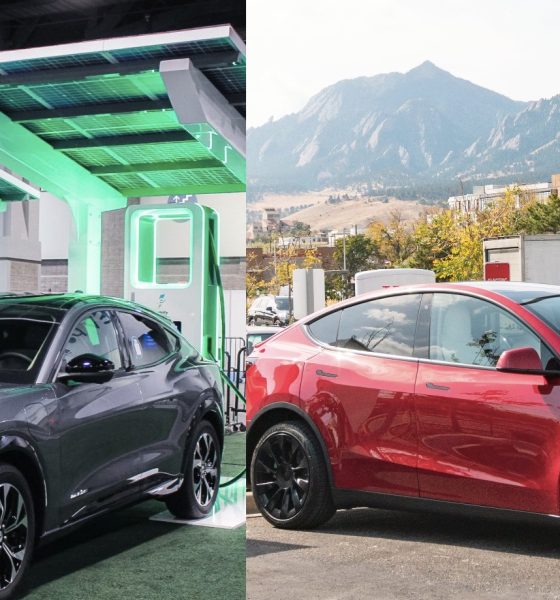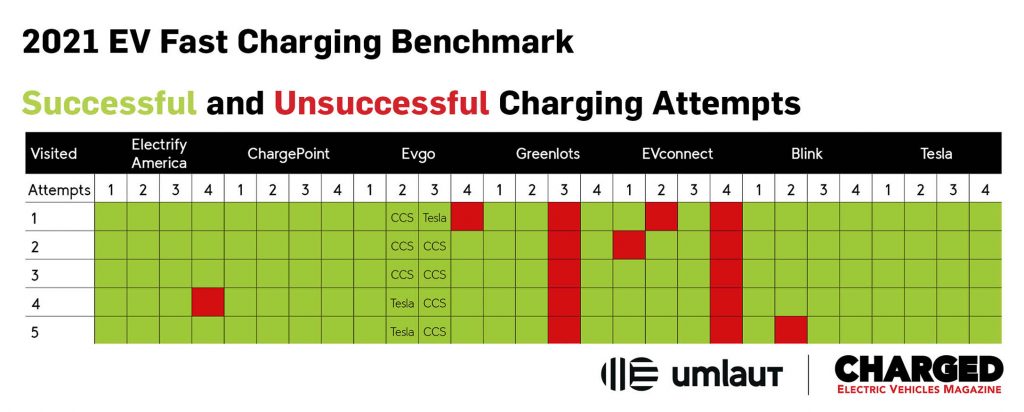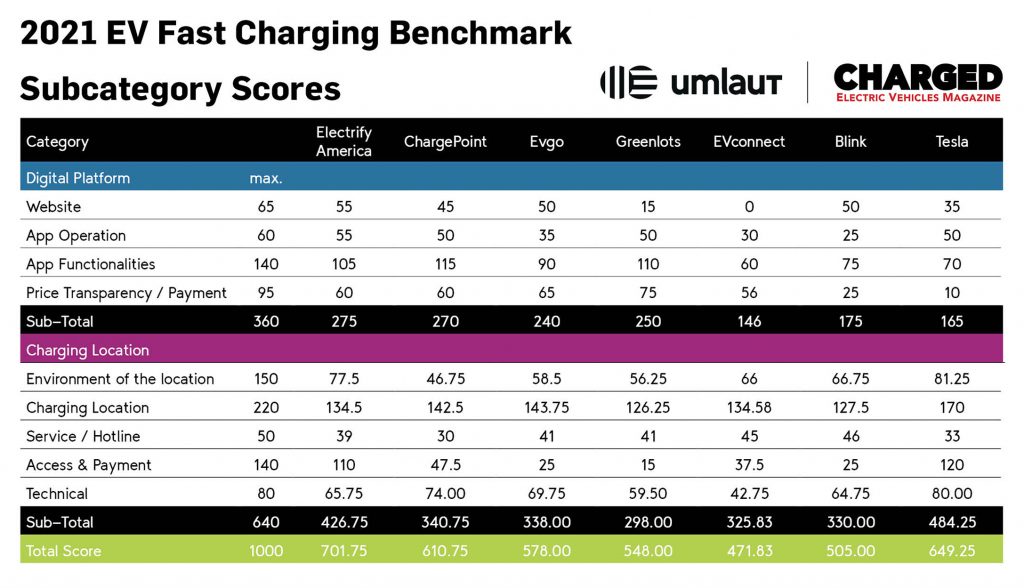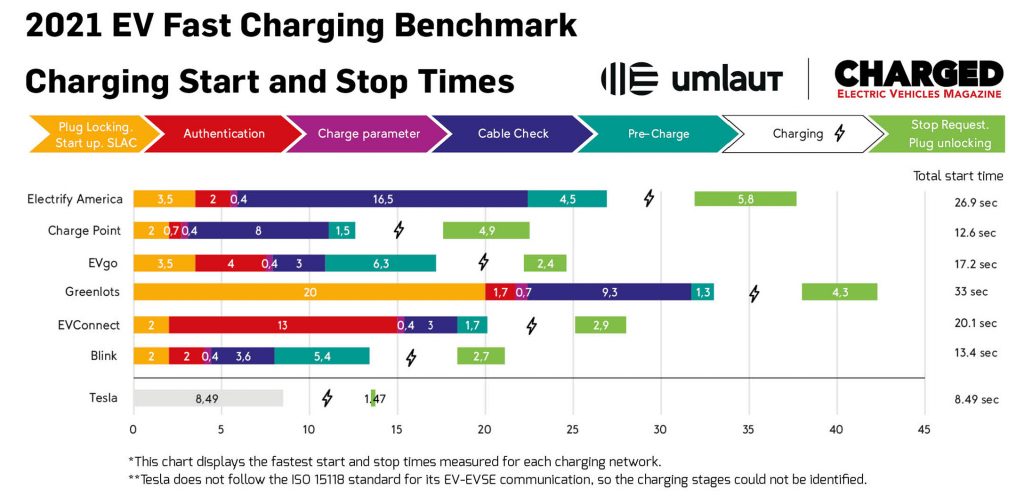

News
Electrify America edges out Tesla Superchargers in 2021 EV Charging Infrastructure Benchmark
Last year, global engineering firm umlaut, which performs benchmarks in various industries, adapted its testing prowess to the United States’ electric vehicle market to determine which public charging network was the best in the country. The effort, which was dubbed as the inaugural 2020 USA EV Charging Infrastructure Benchmark, determined that Electrify America was by far the best public charging network in the United States.
But while the inaugural USA EV Charging Infrastructure Benchmark was notable, there was a popular network that was not included in umlaut’s first analysis: the ubiquitous Tesla Supercharger Network, which is very prevalent but not open to the public like Electrify America. This was why in this year’s USA EV Charging Infrastructure Benchmark, the global engineering firm made it a point to include the Supercharger Network in its study, even if the system had to be scored quite differently due to it being specifically designed for Tesla’s electric cars.

For the 2021 USA EV Charging Infrastructure Benchmark, umlaut performed a comparative study of the country’s fast-charging networks and rated each one using several criteria, specifically: interoperability, pricing, transparency, functionality, and availability, among others. A Tesla Model 3 and a Ford Mustang Mach-E were selected as the vehicles that would used for the study. The EV pair covered 2,100 miles over six days to test charging stations across Michigan, Ohio, Maryland, New Jersey, New York, Connecticut, and Pennsylvania.
To rank the different charging networks, umlaut opted to split its analysis into two areas: the “Digital Platform,” which includes a service’s website and mobile app, and the “Charging Location,” which includes ease of payment, amenities, and the technical performance of the system itself. The results, interestingly enough, revealed that Electrify America was still the overall winner with 702 points due to its balanced scores in the “Digital Platform” and “Charging Location” categories.

Tesla’s Supercharger Network was a second with an overall score of 649. This was quite interesting as Superchargers completely dominated the “Charging Location” metric, earning a perfect score in “Technical Performance” and high scores in the “Access and Payment” subcategories, among others. However, the Supercharger Network lost points in the “Digital Platform” category since Tesla’s website and mobile app were not as useful as those of other networks. This was, of course, partly due to the fact that Tesla’s Supercharger sessions were already integrated into the company’s vehicles themselves.
Despite the challenges presented by the Supercharger Network in this year’s 2021 USA EV Charging Infrastructure Benchmark, umlaut’s Christian Sussbauer noted that Tesla’s charging systems excel in numerous key areas.

“We had a lot of internal discussions about including Tesla Superchargers in this year’s Benchmark because we really want to create a testing system that will capture the right metrics and provide the most useful information to the EV industry. To be honest, if you asked me before we conducted the tests, I think I would have predicted that Tesla Superchargers would end up leading in total points because it’s well known that they do a great job in many aspects of fast charging. And actually, our test results show this clearly—Superchargers excel in many important areas. It’s actually a little boring to test Supercharger stations because you just plug them in, and they reliably work.”
“We were happy to find a very high level of simplicity and reliability with Electrify America this year as well. Using an EV with Plug & Charge enabled on Electrify America’s network was a very good user experience. All of the EV industry should strive to replicate that aspect of Superchargers and Electrify America/Plug & Charge. And in the end, Electrify America also has a very useful smartphone app and website that combined to put them over the top in terms of total points scored for the metrics we were measuring in 2021,” Sussbauer said.
Watch a video about the 2021 USA EV Charging Infrastructure Benchmark below.
Don’t hesitate to contact us with news tips. Just send a message to simon@teslarati.com to give us a heads up.

Elon Musk
Elon Musk’s X will start using a Tesla-like software update strategy
The initiative seems designed to accelerate updates to the social media platform, while maintaining maximum transparency.

Elon Musk’s social media platform X will adopt a Tesla-esque approach to software updates for its algorithm.
The initiative seems designed to accelerate updates to the social media platform, while maintaining maximum transparency.
X’s updates to its updates
As per Musk in a post on X, the social media company will be making a new algorithm to determine what organic and advertising posts are recommended to users. These updates would then be repeated every four weeks.
“We will make the new 𝕏 algorithm, including all code used to determine what organic and advertising posts are recommended to users, open source in 7 days. This will be repeated every 4 weeks, with comprehensive developer notes, to help you understand what changed,” Musk wrote in his post.
The initiative somewhat mirrors Tesla’s over-the-air update model, where vehicle software is regularly refined and pushed to users with detailed release notes. This should allow users to better understand the details of X’s every update and foster a healthy feedback loop for the social media platform.
xAI and X
X, formerly Twitter, has been acquired by Elon Musk’s artificial intelligence startup, xAI last year. Since then, xAI has seen a rapid rise in valuation. Following the company’s the company’s upsized $20 billion Series E funding round, estimates now suggest that xAI is worth tens about $230 to $235 billion. That’s several times larger than Tesla when Elon Musk received his controversial 2018 CEO Performance Award.
As per xAI, the Series E funding round attracted a diverse group of investors, including Valor Equity Partners, Stepstone Group, Fidelity Management & Research Company, Qatar Investment Authority, MGX, and Baron Capital Group, among others. Strategic partners NVIDIA and Cisco Investments also continued support for building the world’s largest GPU clusters.
News
Tesla FSD Supervised wins MotorTrend’s Best Driver Assistance Award
The decision marks a notable reversal for the publication from prior years, with judges citing major real-world improvements that pushed Tesla’s latest FSD software ahead of every competing ADAS system.

Tesla’s Full Self-Driving (Supervised) system has been named the best driver-assistance technology on the market, earning top honors at the 2026 MotorTrend Best Tech Awards.
The decision marks a notable reversal for the publication from prior years, with judges citing major real-world improvements that pushed Tesla’s latest FSD software ahead of every competing ADAS system. And it wasn’t even close.
MotorTrend reverses course
MotorTrend awarded Tesla FSD (Supervised) its 2026 Best Tech Driver Assistance title after extensive testing of the latest v14 software. The publication acknowledged that it had previously criticized earlier versions of FSD for erratic behavior and near-miss incidents, ultimately favoring rivals such as GM’s Super Cruise in earlier evaluations.
According to MotorTrend, the newest iteration of FSD resolved many of those shortcomings. Testers said v14 showed far smoother behavior in complex urban scenarios, including unprotected left turns, traffic circles, emergency vehicles, and dense city streets. While the system still requires constant driver supervision, judges concluded that no other advanced driver-assistance system currently matches its breadth of capability.
Unlike rival systems that rely on combinations of cameras, radar, lidar, and mapped highways, Tesla’s FSD operates using a camera-only approach and is capable of driving on city streets, rural roads, and freeways. MotorTrend stated that pure utility, the ability to handle nearly all road types, ultimately separated FSD from competitors like Ford BlueCruise, GM Super Cruise, and BMW’s Highway Assistant.
High cost and high capability
MotorTrend also addressed FSD’s pricing, which remains significantly higher than rival systems. Tesla currently charges $8,000 for a one-time purchase or $99 per month for a subscription, compared with far lower upfront and subscription costs from other automakers. The publication noted that the premium is justified given FSD’s unmatched scope and continuous software evolution.
Safety remained a central focus of the evaluation. While testers reported collision-free operation over thousands of miles, they noted ongoing concerns around FSD’s configurable driving modes, including options that allow aggressive driving and speeds beyond posted limits. MotorTrend emphasized that, like all Level 2 systems, FSD still depends on a fully attentive human driver at all times.
Despite those caveats, the publication concluded that Tesla’s rapid software progress fundamentally reshaped the competitive landscape. For drivers seeking the most capable hands-on driver-assistance system available today, MotorTrend concluded Tesla FSD (Supervised) now stands alone at the top.
News
Elon Musk’s Grokipedia surges to 5.6M articles, almost 79% of English Wikipedia
The explosive growth marks a major milestone for the AI-powered online encyclopedia, which was launched by Elon Musk’s xAI just months ago.

Elon Musk’s Grokipedia has grown to an impressive 5,615,201 articles as of today, closing in on 79% of the English Wikipedia’s current total of 7,119,376 articles.
The explosive growth marks a major milestone for the AI-powered online encyclopedia, which was launched by Elon Musk’s xAI just months ago. Needless to say, it would only be a matter of time before Grokipedia exceeds English Wikipedia in sheer volume.
Grokipedia’s rapid growth
xAI’s vision for Grokipedia emphasizes neutrality, while Grok’s reasoning capabilities allow for fast drafting and fact-checking. When Elon Musk announced the initiative in late September 2025, he noted that Grokipedia would be an improvement to Wikipedia because it would be designed to avoid bias.
At the time, Musk noted that Grokipedia “is a necessary step towards the xAI goal of understanding the Universe.”
Grokipedia was launched in late October, and while xAI was careful to list it only as Version 0.1 at the time, the online encyclopedia immediately earned praise. Wikipedia co-founder Larry Sanger highlighted the project’s innovative approach, noting how it leverages AI to fill knowledge gaps and enable rapid updates. Netizens also observed how Grokipedia tends to present articles in a more objective manner compared to Wikipedia, which is edited by humans.
Elon Musk’s ambitious plans
With 5,615,201 total articles, Grokipedia has now grown to almost 79% of English Wikipedia’s article base. This is incredibly quick, though Grokipedia remains text-only for now. xAI, for its part, has now updated the online encyclopedia’s iteration to v0.2.
Elon Musk has shared bold ideas for Grokipedia, including sending a record of the entire knowledge base to space as part of xAI’s mission to preserve and expand human understanding. At some point, Musk stated that Grokipedia will be renamed to Encyclopedia Galactica, and it will be sent to the cosmos.
“When Grokipedia is good enough (long way to go), we will change the name to Encyclopedia Galactica. It will be an open source distillation of all knowledge, including audio, images and video. Join xAI to help build the sci-fi version of the Library of Alexandria!” Musk wrote, adding in a later post that “Copies will be etched in stone and sent to the Moon, Mars and beyond. This time, it will not be lost.”








